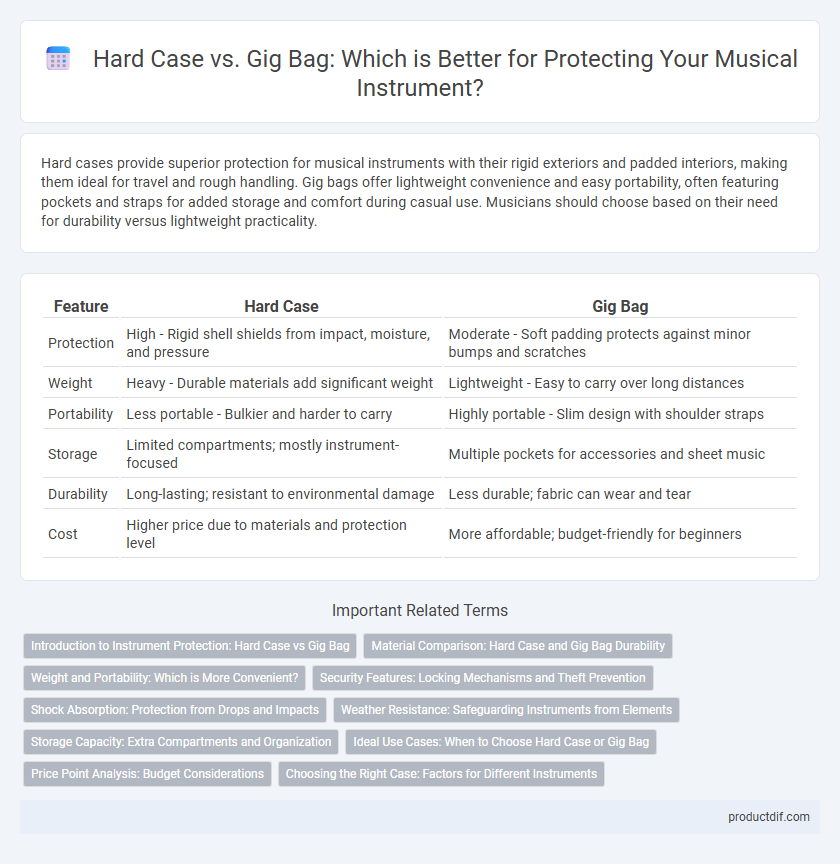Hard cases provide superior protection for musical instruments with their rigid exteriors and padded interiors, making them ideal for travel and rough handling. Gig bags offer lightweight convenience and easy portability, often featuring pockets and straps for added storage and comfort during casual use. Musicians should choose based on their need for durability versus lightweight practicality.
Table of Comparison
| Feature | Hard Case | Gig Bag |
|---|---|---|
| Protection | High - Rigid shell shields from impact, moisture, and pressure | Moderate - Soft padding protects against minor bumps and scratches |
| Weight | Heavy - Durable materials add significant weight | Lightweight - Easy to carry over long distances |
| Portability | Less portable - Bulkier and harder to carry | Highly portable - Slim design with shoulder straps |
| Storage | Limited compartments; mostly instrument-focused | Multiple pockets for accessories and sheet music |
| Durability | Long-lasting; resistant to environmental damage | Less durable; fabric can wear and tear |
| Cost | Higher price due to materials and protection level | More affordable; budget-friendly for beginners |
Introduction to Instrument Protection: Hard Case vs Gig Bag
Hard cases offer robust, impact-resistant protection with rigid shells and padded interiors, making them ideal for safeguarding instruments during travel or rough handling. Gig bags provide lightweight, flexible protection, often featuring padded compartments and multiple pockets, suitable for everyday use and easy transport. Choosing between a hard case and gig bag depends on the level of protection needed, portability, and frequency of instrument transportation.
Material Comparison: Hard Case and Gig Bag Durability
Hard cases offer superior durability due to their rigid construction, typically made from molded plastic, wood, or metal, providing excellent protection against impacts and environmental damage. Gig bags are generally made from padded nylon or polyester fabric, offering lightweight and water-resistant qualities but less protection against heavy impacts or crushing. Musicians prioritizing long-term instrument safety often choose hard cases, while gig bags appeal to those seeking portability and moderate protection.
Weight and Portability: Which is More Convenient?
Hard cases are significantly heavier due to their rigid materials like wood or molded plastic, offering superior protection but less portability compared to gig bags made from lightweight nylon or polyester. Gig bags often weigh between 2 to 5 pounds, enhancing ease of transport for musicians who frequently travel or carry their instruments long distances. Musicians prioritizing convenience and lightness typically prefer gig bags, while those seeking maximum protection for air travel or rough handling opt for sturdier hard cases despite the extra weight.
Security Features: Locking Mechanisms and Theft Prevention
Hard cases offer superior security features with robust locking mechanisms such as combination locks and metal latches that effectively prevent theft and unauthorized access. Gig bags generally lack advanced locking systems, relying on zippers and flap closures that provide minimal protection against break-ins. Musicians prioritizing theft prevention and durability typically choose hard cases for enhanced security during transport and storage.
Shock Absorption: Protection from Drops and Impacts
Hard cases provide superior shock absorption with rigid outer shells and plush interiors that protect musical instruments from drops and impacts. Gig bags feature padded layers offering moderate cushioning but lack the structural rigidity to shield against severe shocks. Musicians prioritizing maximum impact protection often prefer hard cases for secure transport.
Weather Resistance: Safeguarding Instruments from Elements
Hard cases provide superior weather resistance, featuring robust materials like molded plastic or reinforced wood that protect instruments from rain, humidity, and temperature fluctuations. Gig bags, typically made from nylon or polyester with minimal padding, offer limited protection against moisture and are more susceptible to water damage during heavy rain or high humidity. For musicians frequently exposed to harsh weather, hard cases ensure better safeguarding of delicate instrument components and maintain tonal integrity.
Storage Capacity: Extra Compartments and Organization
Hard cases offer superior storage capacity with multiple reinforced compartments designed to securely hold accessories like pedals, tuners, and cables, providing organized space that prevents damage during transport. Gig bags typically feature fewer and smaller pockets, often only accommodating basic essentials such as sheet music and picks, which limits their organizational utility for musicians carrying numerous tools. The rigid structure of hard cases ensures that stored items remain stable and protected, enhancing overall instrument care compared to the flexible, less compartmentalized design of gig bags.
Ideal Use Cases: When to Choose Hard Case or Gig Bag
Hard cases suit musicians who require maximum protection during travel, especially for air transport or rugged conditions, ensuring the instrument remains safe from impact and weather. Gig bags offer lightweight convenience and ease of transport, ideal for casual players or those frequently moving between local gigs and practice sessions. Choosing depends on balancing protection needs with portability, where professional touring demands hard cases, while everyday, low-risk commutes favor gig bags.
Price Point Analysis: Budget Considerations
Hard cases typically range from $100 to $300, offering superior protection and durability, making them ideal for professional musicians or frequent travelers willing to invest in long-term equipment safety. Gig bags usually cost between $20 and $80, providing a lightweight, affordable solution suited for students or casual players prioritizing portability over maximum defense. Budget considerations hinge on weighing initial investment against protection needs and usage frequency, as gig bags minimize upfront costs while hard cases reduce potential repair or replacement expenses.
Choosing the Right Case: Factors for Different Instruments
Selecting the right case depends on the instrument's size, fragility, and intended use; hard cases offer superior protection for delicate or expensive instruments like violins and trumpets, while gig bags provide lightweight, portable options ideal for electric guitars and keyboards. Consider the frequency of travel, weather resistance, and storage needs to balance durability with convenience. Musicians prioritizing protection in rough conditions benefit from hard cases, whereas those seeking ease of transport often prefer gig bags.
Hard case vs Gig bag Infographic

 productdif.com
productdif.com